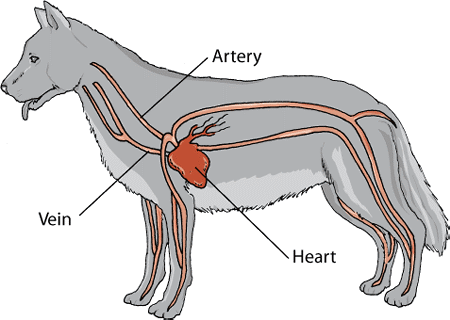
It consists of the heart and blood vessels namely arteries veins and capillaries. In all vertebrate organisms this is a closed-loop system in which the blood is largely separated from the bodys other extracellular fluid compartment the interstitial fluid which is the fluid bathing the cells.

The right side of the heart pumps blood to the lungs.
Circulatory system of dog. The cardiovascular system or circulatory system is the system responsible for circulating blood throughout the dogs body. It consists of the heart and blood vessels namely arteries veins and capillaries. The system that is called the circulatory system of the dog is comprised of the blood the blood vessels and the heart.
The heart of the dog is a four chambered structure that consists of the right and left upper chambers called the atria and the two lower chambers that are called the ventricles. Essentially the heart is a two sided pump a right. This occurs in the lungs where the circulatory system can then transport oxygen to tissue used in internal respiration to burn fuel in the form of adenosine triosphate for energy this then creates more carbon dioxide.
The dog will breath oxygen unto its lungs. Circulatory system of a dog. Cardiovascular system of the dog.
Introduction to Heart and Blood Vessel Disorders in Dogs The cardiovascular system includes the heart and the blood vessels the veins and the arteries. The function of the heart is to pump blood. The right side of the heart pumps blood to the lungs.
The circulatory and respiratory system work together in order for the dog to be able to consistently move and exercise. When the dog is resting it is in the process of aerobic respiration. As the dog begins to exercise its muscles require more energy in.
The Cardiovascular System of a Dog. The cardiovascular system includes the heart and blood vessels and performs the function of pumping and carrying blood to the rest of the body. The blood contains nutrients and oxygen to provide energy to.
Most vertebrates and some invertebrates like this annelid earthworm have a closed circulatory system. In b open circulatory systems a fluid called hemolymph is pumped through a blood vessel that empties into the body cavity. Hemolymph returns to the blood vessel through openings called ostia.
The respiratory system includes the. Lungs and Smaller Airways bronchi and bronchioles The respiratory system is responsible for taking in oxygen and eliminating waste gases like carbon dioxide. Because dogs and cats do not sweat through the skin the respiratory system also plays an important role in regulation of temperature.
The circulatory system is a network of vesselsthe arteries veins and capillariesand a pump the heart. In all vertebrate organisms this is a closed-loop system in which the blood is largely separated from the bodys other extracellular fluid compartment the interstitial fluid which is the fluid bathing the cells. The Circulatory System is known as a closed system because the blood is contained within either the heart or blood vessels at all times always flowing in one direction.
The path is the same heart ventricles arteries arterioles organ capillaries veins heart atrium 2. Except for the capillaries all blood vessels have. The components of the circulatory system.
Blood vessels - the arteries veins and capillaries. The heart acts as a pump that pushes blood throughout the body to reach all the tissues. There are two types of the circulatory system present in animals.
The circulatory system evolved as an efficient method to pump important nutrients and collect waste materials throughout the body. The earliest circulatory system resembled todays open circulatory system where blood flowed in a hollow enclosed space. Closed circulation evolved much later in ancestors of vertebrates.
An open circulatory system is one in which there is a mixing of the blood and interstitial fluid fluid that fills the space surrounding cells to make up the hemolymph. It is pumped into a cavity. How does the circulatory system work.
The circulatory system is made up of blood vessels that carry blood away from and towards the heart. Arteries carry blood away from the heart and veins carry blood back to the heart. The circulatory system carries oxygen nutrients and hormones to cells and removes waste products like carbon dioxide.
An animal showing signs due to relative inadequacy of the cardiovascular system to deliver enough blood to sustain normal function is said to be in low output or forward heart failure. An animal showing signs caused by buildup of fluid or congestion in poorly drained organs is said to be in congestive heart failure CHF. Frogs have a three-chambered heart.
It consists of two atria and one ventricle. Birds and mammals however have a fully septated ventriclea bona fide four-chambered heart. This configuration ensures the separation of low-pressure circulation to the lungs and high-pressure pumping into the rest of the body.
The dog circulatory system as with humans is a closed system that consists of the heart the arteries and the veins. Advertisement In a closed circulatory system blood travels through a loop. Blood enters the right atrium of the heart through the two vena cava.
From there the blood enters the right ventricle and is pumped through the. In most animals the circulatory system is used to transport blood through the body. Some primitive animals use diffusion for the exchange of water nutrients and gases.
However complex organisms use the circulatory system to carry. Circulatory Systems in Animals. Basic Components of All Circulatory Systems A fluid blood that serves as a medium of transport A system of channels or vessels that conduct the blood throughout the body A pump the heart that keeps the blood circulating.
Types of Circulatory Systems 1 Open Circulatory System example.